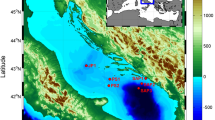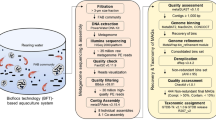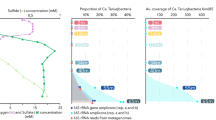Abstract
In aquatic environments, community dynamics of bacteria, especially actively growing bacteria (AGB), are tightly linked with dissolved organic matter (DOM) quantity and quality. We analyzed the community dynamics of DNA-synthesizing and accordingly AGB by linking an improved bromodeoxyuridine immunocytochemistry approach with fluorescence-activated cell sorting (BrdU-FACS). FACS-sorted cells of even oligotrophic ecosystems in winter were characterized by 16S rRNA gene analysis. In incubation experiments, we examined community shifts of AGB in response to the addition of N-acetyl-glucosamine (NAG), one of the most abundant aminosugars in aquatic systems. Our improved BrdU-FACS analysis revealed that AGB winter communities of oligotrophic Lake Stechlin (northeastern Germany) substantially differ from those of total bacteria and consist of Alpha-, Beta-, Gamma-, Deltaproteobacteria, Actinobacteria, Candidatus OP10 and Chloroflexi. AGB populations with different BrdU-fluorescence intensities and cell sizes represented different phylotypes suggesting that single-cell growth potential varies at the taxon level. NAG incubation experiments demonstrated that a variety of widespread taxa related to Alpha-, Beta-, Gammaproteobacteria, Bacteroidetes, Actinobacteria, Firmicutes, Planctomycetes, Spirochaetes, Verrucomicrobia and Chloroflexi actively grow in the presence of NAG. The BrdU-FACS approach enables detailed phylogenetic studies of AGB and, thus, to identify those phylotypes which are potential key players in aquatic DOM cycling.
Similar content being viewed by others
Log in or create a free account to read this content
Gain free access to this article, as well as selected content from this journal and more on nature.com
or
References
Allgaier M, Grossart H-P . (2006). Diversity and seasonal dynamics of Actinobacteria populations in four lakes in northeastern Germany. Appl Environ Microbiol 72: 3489–3497.
Allgaier M, Brückner S, Jaspers E, Grossart H-P . (2007). Intra- and inter-lake variability of free-living and particle-associated Actinobacteria communities. Environ Microbiol 9: 2728–2741.
Alonso C, Pernthaler J . (2005). Incorporation of glucose under anoxic conditions by bacterioplankton from coastal North Sea surface waters. Appl Environ Microbiol 71: 1709–1716.
Alonso C, Zeder M, Piccini C, Conde D, Pernthaler J . (2009). Ecophysiological differences of betaproteobacterial populations in two hydrochemically distinct compartments of a subtropical lagoon. Environ Microbiol 11: 867–876.
Alonso-Sáez L, Gasol JM . (2007). Seasonal variation in the contribution of different bacterial groups to the uptake of low molecular weight-compounds in NW Mediterranean coastal waters. Appl Environ Microbiol 73: 3528–3535.
Azam F . (1998). Microbial control of oceanic carbon flux: the plot thickens. Science 280: 694–696.
Beier S, Bertilsson S . (2011). Uncoupling of chitinase activity and uptake of hydrolyses products in freshwater bacterioplankton. Limnol Oceanogr 56: 1179–1188.
Buck U, Grossart H-P, Amann R, Pernthaler J . (2009). Substrate incorporation patterns of bacterioplankton populations in stratified and mixed waters of a humic lake. Environ Microbiol 11: 1854–1865.
Burkert U, Warnecke F, Babenzien D, Zwirnmann E, Pernthaler J . (2003). Members of a readily enriched β-proteobacterial clade are common in surface waters of a humic lake. Appl Environ Microbiol 69: 6550–6559.
Campbell BJ, Yu LY, Straza TRA, Kirchman DL . (2009). Temporal changes in bacterial rRNA and rRNA genes in Delaware coastal waters. Aquat Microb Ecol 57: 123–135.
Campbell BJ, Yu L, Heidelberg JF, Kirchman DL . (2011). Activity of abundant and rare bacteria in a coastal ocean. Proc Natl Acad Sci USA 108: 12776–12781.
Cloud-Hansen KA, Peterson SB, Stabb EV, Goldman WE, McFall-Ngai MJ, Handelsman J . (2006). Breaching the great wall: peptidoglycan and microbial interactions. Nat Rev Microbiol 4: 710–716.
Cottrell MT, Kirchman DL . (2000). Natural assemblages of marine proteobacteria and members of the Cytophaga–Flavobacter cluster consuming low- and high-molecular-weight dissolved organic matter. Appl Environ Microbiol 66: 1692–1697.
Eckert EM, Salcher MM, Posch T, Eugster B, Pernthaler J . (2012). Rapid successions affect microbial N-acetyl-glucosamine uptake patterns during a lacustrine spring phytoplankton bloom. Environ Microbiol 14: 794–806.
Eiler A, Bertilsson S . (2007). Flavobacteria blooms in four eutrophic lakes: linking population dynamics of freshwater bacterioplankton to resource availability. Appl Environ Microbiol 73: 3511–3518.
Fegatella F, Lim J, Kjelleberg S, Cavicchioli R . (1998). Implications of rRNA operon copy number and ribosome content in the marine oligotrophic ultramicrobacterium Sphingomonas sp. strain RB2256. Appl Environ Microbiol 64: 4433–4438.
Fuhrman JA, Azam F . (1982). Thymidine incorporation as a measure of heterotrophic bacterioplankton production in marine surface waters: evaluation and field results. Mar Biol 66: 109–120.
Garcia SL, McMahon KD, Martinez-Garcia M, Srivastava A, Sczyrba A, Stepanauskas R et al (2013). Metabolic potential of a single cell belonging to one of the most abundant lineages in freshwater bacterioplankton. ISME J 7: 137–147.
Gentile G, Giuliano L, D'Auria G, Smedile F, Azzaro M, De Domenico M et al (2006). Study of bacterial communities in Antarctic coastal waters by a combination of 16S rRNA and 16S rDNA sequencing. Environ Microbiol 8: 2150–2161.
Giovannoni SJ, Tripp HJ, Givan S, Podar M, Vergin KL, Baptista D et al (2005). Genome streamlining in a cosmopolitan oceanic bacterium. Science 309: 1242–1245.
Giroldo D, Vieira AAH, Paulsen BS . (2003). Relative increase of deoxy sugars during microbial degradation of an extracellular polysaccharide released by a tropical freshwater Thalassiosira sp. (Bacillariophyceae). J Phycol 39: 1109–1115.
Glöckner F-O, Zaichikov E, Belkova N, Denissova L, Pernthaler J, Pernthaler A et al (2000). Comparative 16S rRNA analysis of lake bacterioplankton reveals globally distributed phylogenetic clusters including an abundant group of actinobacteria. Appl Environ Microbiol 66: 5053–5065.
Hahn MW, Lünsdorf H, Wu Q, Schauer M, Höfle MG, Boenigk J et al (2003). Isolation of novel ultramicrobacteria classified as actinobacteria from five freshwater habitats in Europe and Asia. Appl Environ Microbiol 69: 1442–1451.
Hahn MW, Pöckl M, Wu QL . (2005). Low intraspecific diversity in a Polynucleobacter subcluster population numerically dominating bacterioplankton of a freshwater pond. Appl Environ Microbiol 71: 4539–4547.
Hahn MW, Kasalický V, Jezbera J, Brandt U, Jezberová J, Šimek K . (2010a). Limnohabitans curvus gen. nov., sp. nov., a planktonic bacterium isolated from a freshwater lake. Int J Syst Evol Microbiol 60: 1358–1365.
Hahn MW, Kasalický V, Jazbera J, Brandt U, Šimek K . (2010b). Limnohabitans australis sp. nov., isolated from freshwater pond, and emended description of the genus Limnohabitans. Int J Syst Evol Microbiol 60: 2946–2950.
Hamasaki K, Long RA, Azam F . (2004). Individual cell growth rates of marine bacteria, measured by bromodeoxyuridine incorporation. Aquat Microb Ecol 35: 217–227.
Hunt DE, David LA, Gevers D, Preheim SP, Alm EJ, Polz MF . (2008). Resource partitioning and sympatric differentiation among closely related bacterioplankton. Science 320: 1081–1085.
Jones SE, Newton RJ, McMahon KD . (2009). Evidence for structuring of bacterial community composition by organic carbon source in temperate lakes. Environ Microbiol 11: 2463–2472.
Jones SE, Lennon JT . (2010). Dormancy contributes to the maintenance of microbial diversity. Proc Natl Acad Sci USA 107: 5881–5886.
Jørgensen NOG, Stepanaukas R, Pedersen AGU, Hansen M, Nybroe O . (2003). Occurrence and degradation of peptidoglycan in aquatic environments. FEMS Microbiol Ecol 46: 269–280.
Kasalický V, Jezbera J, Šimek K, Hahn MW . (2010). Limnohabitans planktonicus sp. nov., and Limnohabitans parvus sp. nov., two novel planktonic Betaproteobacteria isolated from a freshwater reservoir. Int J Syst Evol Microbiol 60: 2710–2714.
Kasalický V, Jezbera J, Šimek K, Hahn MW . (2013). The diversity of the Limnohabitans genus, an important group of freshwater bacterioplankton, by characterization of 35 isolated strains. PLoS One 8: e58205.
Kemp PF, Lee S, LaRoche J . (1993). Estimating the growth rate of slowly growing marine bacteria from RNA content. Appl Environ Microbiol 59: 2594–2601.
Kerkhof L, Kemp P . (1999). Small ribosomal RNA content in marine Proteobacteria during non-steady-state growth. FEMS. Microbiol Ecol 30: 253–260.
Kirchman D, K'Ness E, Hodson R . (1985). Leucine incorporation and its potential as a measure of protein synthesis by bacteria in natural aquatic systems. Appl Environ Microbiol 49: 599–607.
Lami R, Ghiglione JF, Desdevises Y, West NJ, Lebaron P . (2009). Annual patterns of presence and activity of marine bacteria monitored by 16S rDNA–16S rRNA fingerprints in the coastal NW Mediterranean Sea. Aquat Microb Ecol 54: 199–210.
Lee BG, Fisher NS . (1992). Decomposition and release of elements from zooplankton debris. Mar Ecol Prog Ser 88: 117–128.
Lee N, Nielsen PH, Andreasen KH, Juretschko S, Nielsen JL, Schleifer KH et al (1999). Combination of fluorescent in situ hybridization and microautoradiography – a new tool for structure–function analyses in microbial ecology. Appl Environ Microbiol 65: 1289–1297.
Li W, Godzik A . (2006). Cd-hit: a fast program for clustering and comparing large sets of protein or nucleotide sequences. Bioinformatics 22: 1658–1659.
Miwa H, Ahmed I, Yoon J, Yokota A, Fujiwara T . (2008). Variovorax boronicumulans sp. nov., a boron-accumulating bacterium isolated from soil. Int J Syst Evol Microbiol 58: 286–289.
Mou X, Hodson RE, Moran MA . (2007). Bacterioplankton assemblages transforming dissolved organic compounds in coastal seawater. Environ Microbiol 9: 2025–2037.
Nedoma J, Vrba J, Hejzlar J, Šimek K, Straskrabová V . (1994). N-acetylglucosamine dynamics in fresh-warer environments – concentration of amino-sugars, extracellular enzyme-activities, and microbial uptake. Limnol Oceanogr 39: 1088–1100.
Newton RJ, Jones SE, Helmus MR, McMahon KD . (2007). Phylogenetic ecology of the freshwater Actinobacteria acI lineage. Appl Environ Microbiol 73: 7169–7176.
Newton RJ, Jones SE, Eiler A, McMahon KD, Bertilsson S . (2011). A guide to the natural history of freshwater lake bacteria. Microbiol Mol Biol Rev 75: 14–49.
Pernthaler J, Posch T, Šimek K, Vrba J, Pernthaler A, Glöckner FO et al (2001). Predator-specific enrichment of actinobacteria from a cosmopolitan freshwater clade in mixed continuous culture. Appl Environ Microbiol 67: 2145–2155.
Pernthaler A, Pernthaler J, Schattenhofer M, Amann R . (2002). Identification of DNA-synthesizing bacterial cells in coastal North Sea plankton. Appl Environ Microbiol 68: 5728–5736.
Riemann L, Azam F . (2002). Widespread N-acetyl-d-glucosamine uptake among pelagic marine bacteria and its ecological implications. Appl Environ Microbiol 68: 5554–5562.
Rösel S, Grossart H-P . (2012). Contrasting dynamics in activity and community composition of free-living and particle-associated bacteria in spring. Aquat Microb Ecol 66: 169–181.
Rösel S, Allgaier M, Grossart H-P . (2012). Long-term characterization of free-living and particle-associated bacterial communities in Lake Tiefwaren reveals distinct seasonal patterns. Microb Ecol 64: 571–583.
Salcher MM, Pernthaler J, Posch T . (2010). Spatiotemporal distribution and activity patterns of bacteria from three phylogenetic groups in an oligomesotrophic lake. Limnol Oceanogr 55: 846–856.
Schäfer H, Bernard L, Courties C, Lebaron P, Servais P, Pukall R et al (2001). Microbial community dynamics in Mediterraneen nutrient-enriched seawater mesocosms: changes in the genetic diversity of bacterial populations. FEMS Microbiol Ecol 34: 243–253.
Schäfer H, Muyzer G . (2001) Denaturing Gradient Gel Electrophoresis in Marine Microbial Ecology. Academic Press: San Diego, CA, USA.
Šimek K, Pernthaler J, Weinbauer MG, Hornak K, Dolan JR, Nedoma J et al (2001). Changes in bacterial community composition and dynamics and viral mortality rates associated with enhanced flagellate grazing in a mesoeutrophic reservoir. Appl Environ Microbiol 67: 2723–2733.
Steward GF, Azam F . (1999). Bromodeoxyuridine as an alternative to 3H-thymidine for measuring bacterial productivity in aquatic samples. Aquat Microb Ecol 19: 57–66.
Tada Y, Taniguchi A, Hamasaki K . (2010). Phylotype-specific growth rates of marine bacteria measured by bromodeoxyuridine immunocytochemistry and fluorescence in situ hybridization. Aquat Microb Ecol 59: 229–238.
Tada Y, Taniguchi A, Nagao I, Miki T, Uematsu M, Tsuda A et al (2011). Differing growth responses of major phylogenetic groups of marine bacteria to natural phytoplankton blooms in the western North Pacific Ocean. Appl Environ Microbiol 77: 4055–4065.
Tamura K, Peterson D, Peterson N, Stecher G, Nei M, Kumar S . (2011). MEGA5: molecular evolutionary genetics analysis using maximum likelihood, evolutionary distance, and maximum parsimony methods. Mol Biol Evol 28: 2731–2739.
Taniguchi A, Hamasaki K . (2008). Community structures of actively growing bacteria shift along a north-south transect in the western North Pacific. Environ Microbiol 10: 1007–1017.
Tang KW, Bickel SL, Dziallas C, Grossart H-P . (2009). Microbial activities accompanying decomposition of cladoceran and copepod carcasses under different environmental conditions. Aquat Microb Ecol 57: 89–100.
Thingstad TF . (2000). Elements of a theory for the mechanisms controlling abundance, diversity, and biogeochemical role of lytic bacterial viruses in aquatic systems. Limnol Oceanogr 45: 1320–1328.
Urbach E, Vergin KL, Giovannoni SJ . (1999). Immunochemical detection and isolation of DNA from metabolically active bacteria. Appl Environ Microbiol 65: 1207–1213.
Warnecke F, Sommaruga R, Seka R, Hofer J, Pernthaler J . (2005). Abundances, identity, and growth state of Actinobacteria in mountain lakes of different UV transparency. Appl Environ Microbiol 71: 5551–5559.
Weinbauer MG, Höfle MG . (1998). Significance of viral lysis and flagellate grazing as controlling factors of bacterioplankton production in a eutrophic lake. Appl Environ Microbiol 64: 431–438.
Wright ES, Yilmaz LS, Noguera DR . (2012). DECIPHER, a search-based approach to chimera identification for 16S rRNA gene sequences. Appl Environ Microbiol 78: 717–725.
Wu QL, Hahn MW . (2006a). Differences in structure and dynamics of Polynucleobacter communities in a temperate and a subtropical lake, revealed at three phylogenetic levels. FEMS Microbiol Ecol 57: 67–79.
Wu QL, Hahn MW . (2006b). High predictability of the seasonal dynamics of a species-like Polynucleobacter population in a freshwater lake. Environ Microbiol 8: 1660–1666.
Wurzbacher C, Grossart H-P . (2012). Improved detection and identification of aquatic fungi and chitin in aquatic environments. Mycologia 104: 1267–1271.
Yoon J-H, Kang S-J, Oh T-K . (2006). Variovorax dokdonensis sp. nov., isolated from soil. Int J Syst Evol Microbiol 56: 811–814.
Zeng Y, Kasalický V, Šimek K, Koblížek M . (2012). Genome sequence of two freshwater betaproteobacterial isolates, Limnohabitans species strains Rim 28 and Rim 47, indicate their capabilities as both photoautotrophs and ammonia oxidizers. J Bacteriol 194: 6302–6303.
Acknowledgements
We thank Solvig Pinnow for excellent technical assistance and Claudia Dziallas for valuable discussions. We also thank Koji Hamasaki, Koji Suzuki and Hisashi Endo for their great support for this study. We appreciate the help by members of the MIBI group and the technical stuff of IGB Neuglobsow. This study was supported by a fellowship of the Leibniz Institute of Freshwater Ecology and Inland Fisheries (IGB) and by a grant of the German Science Foundation (DFG-GR1540/17-1).
Author information
Authors and Affiliations
Corresponding author
Additional information
Supplementary Information accompanies this paper on The ISME Journal website
Rights and permissions
About this article
Cite this article
Tada, Y., Grossart, HP. Community shifts of actively growing lake bacteria after N-acetyl-glucosamine addition: improving the BrdU-FACS method. ISME J 8, 441–454 (2014). https://doi.org/10.1038/ismej.2013.148
Received:
Revised:
Accepted:
Published:
Issue date:
DOI: https://doi.org/10.1038/ismej.2013.148
Keywords
This article is cited by
-
Exploring the nature, origins and ecological significance of dissolved organic matter in freshwaters: state of the science and new directions
Biogeochemistry (2023)
-
Ailanthone inhibits non-small cell lung cancer cell growth through repressing DNA replication via downregulating RPA1
British Journal of Cancer (2017)
-
Comparative single-cell genomics reveals potential ecological niches for the freshwater acI Actinobacteria lineage
The ISME Journal (2014)



